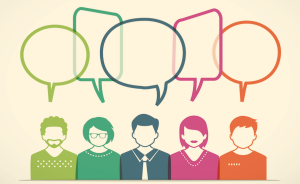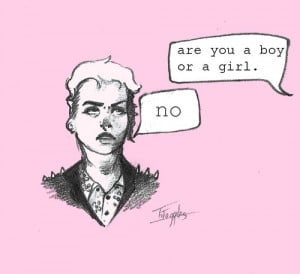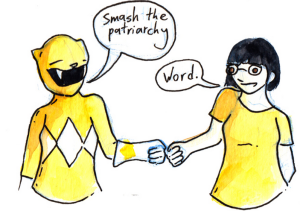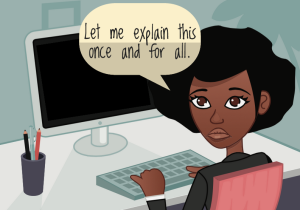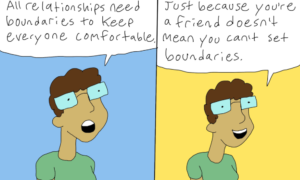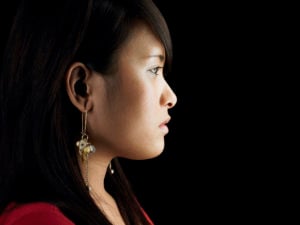We all know that dialogue is necessary in helping us, as feminists, think through and unmask complicated systems of privilege and oppression.
Indeed, it is largely through solid dialogue that we can challenge ourselves and others to think differently about the world.
That’s when ideas change – which is vital for creating a more just society and fighting against oppression.
If it wasn’t for intentional dialogue about street harassment, for example, cis men wouldn’t know how much we need them to be better allies to women and gender nonconforming people – or how to do it.
Only there’s a major problem: We don’t always know how to practice effective dialogue.
Too often, because we’re more interested in expressing our opinions, we fail to take the perceptions of our co-dialoguers seriously.
And we’ve all experienced failed dialogue:
- “Oh no, that’s not what I meant.”
- “I’m not yelling. Why are you yelling?”
- “You do x. You think y. You you you you you.”
- “Ah, you’re just a feminist/socialist/communist/liberal/Democrat.”
- “Ah, you’re just a libertarian/conservative/Tea Partier/Republican.”
Failed dialogue is all work and no reward.
And trust me when I say I can relate.
I, too, have found myself passionately, but ineffectively, dialoguing with other folks about social justice topics I care about.
I didn’t take the other persons’ experiences and feelings seriously, nor did I create an opportunity for them to actively participate in the conversation. Instead, I was more interested in convincing them to change their minds and arguing against their points.
Consequently, the people I was attempting to dialogue with felt belittled, attacked and closed off to new ideas while I ended up frustrated, angry and deflated because they just wouldn’t “get it.”
I also became “typecast” as a hippy devoid of critical thought.
Because my dialogue had been ineffective, I wasn’t changing minds. And when I spoke up later, I’d see eyes roll and heads shake that implied, “Well, here we go again.”
That’s a horrible experience. Not only does it contribute to activist burnout, but it also means that oppressive biases are not being weakened.
So, if we really want to increase understanding with others, if we want to strive towards strong allyship, and if want our feminism to have its most profound and long-lasting impact, we must address the shortcomings in our approaches to communication.
We must engage in effective dialogue.
What Is Effective Dialogue (And What Should It Accomplish)?
First, it is critical that we understand the difference between dialogue and explanation: Dialoguing is not about explaining.
People often mistake explaining for dialogue because it seems like an exchange of ideas.
Explaining, though, is a tool to silence folks because it does not establish a safe, collaborative relationship where two or more people can share ideas and experiences.
Explaining, especially when it is non-consensual, is an imposition because it speaks for and over others.
And just as a teacher cannot think for their students, neither can a feminist think for the individuals with whom they converse.
Dialogue, however, is a mutual exchange of knowledge based on one’s experiences in and of the world. Through such collaboration, people are able to transform their lived experiences into knowledge.
When feminists engage in dialogue, it should be vested in social justice, in revealing and destabilizing systems of oppression.
Therefore, we can educate one another, using the feminist concepts we might have learned in academia, literature, or in the social justice activist realm as well as, and possibly most critically, our experiences with the world.
Through this process, we come to understand that ideas and practices in society are not “natural” or cut in stone. Instead, we realize that we each produce and reproduce social norms.
This is so important!
It reveals that privileged groups reproduce the prejudicial ideas and systems that benefit them while marginalizing others.
And it reveals that marginalized groups can effectively struggle to make the structures of society less oppressive.
Effective feminist dialogue, therefore, should be a collaborative experience tasked with the creation of anti-oppressive knowledge and practices.
What, then, are the steps for effective feminist dialogue?
1. Be Ready and Open to Dialogue
A white female friend of mine once told me that Affirmative Action is “reverse racism.”
She went on to suggest that most People of Color in positions of power did not have to work hard to get there; they were most likely given the job because of their race, thus “stealing” it from a more deserving white person.
There are a number of problematic assumptions in that statement.
However, before engaging in a dialogue with her about it, I had to evaluate if I felt that I could.
There are a number of contexts when I feel like I should start a dialogue with someone (or a group of people), but for whatever reason, the time just isn’t right.
I might not feel safe. I might be tired. I might not feel like I’m equipped with necessary knowledge. I might not have sufficient time.
The same could apply to the person(s) with whom I want to dialogue.
And that’s okay.
Dialogue can be a challenging, time-consuming, mentally and emotionally exhausting activity for everyone involved. So, everybody must feel comfortable and ready to dialogue – to a point.
Systems of privilege are sometimes difficult to face, and occasionally people are reluctant to engage in dialogue that would force them to acknowledge their complicity in oppressive ideas and practices.
So, while dialogue must be consensual, we shouldn’t sacrifice it for someone else’s comfort, especially if their comfort is the product of unearned benefits of privilege.
And we shouldn’t avoid dialogue because of some misguided, privileged demand for patience in the face of ongoing oppression.
Engaging in social justice discourses is important now, even if it is going to make some feel uncomfortable.
Nonetheless, we must make sure that the timing and setting feel right.
2. Do Research If You Can (And Accessibly Introduce Your Ideas)
On the one hand, dialogue requires at least a preliminary knowledge of concepts related to feminism and social justice.
This does not mean that we must be experts.
But, before dialoguing with someone, I usually explore the topic(s) I’ll be discussing. I read over a few articles, check out some vlogs or comics and/or talk to a friend or colleague who is more familiar with the ideas I plan to introduce.
Basic familiarity with feminist ideas not only strengthens my arguments, but it also helps me to feel comfortable and confident engaging in dialogue.
At the same time, the language that we use to discuss important concepts should be accessible, especially to those unversed in feminist literature.
That way, dialoguing stays mutual. Our co-dialoguers remain willing and comfortable to converse because they don’t interpret our ideas as imposing, threatening or silencing.
This does not mean to water-down ideas, though.
Systems of oppression are complicated. They’re intended to be, in order to render them less visible.
Diluting this complexity, however, is quite literally a “white wash” (a bleaching that privileges white, not to mention wealthy, able-bodied, heteronormative and cis-gender male narratives).
On the other hand, though, I don’t only rely on concepts.
I also evoke personal experiences.
This means sharing (to the degree that I feel comfortable and safe) my own experiences around a given topic and inviting my co-dialoguer(s) to do the same.
In the case of the friend I mentioned above – after determining that we felt capable of engaging in dialogue with each other, I discussed ongoing issues of institutionalized racism in the US.
I didn’t use the term “institutionalized racism,” though. Instead, I mentioned racial disparities related to education and housing, for example. And, I told of the discrimination I encountered in school and the workplace as a Puerto Rican male growing up in a primarily Anglo town.
I also encouraged my friend to share any of her stories that might relate to the question of racism and Affirmative Action.
I try to remember that I cannot think for my co-dialoguer.
Dialogue cannot be an imposition. Instead, it should be collaborative, an opportunity to create ideas together. Otherwise, it risks alienating our co-dialoguers from our social justice aims.
There is a lot that we can and must learn from each other.
My co-dialoguer(s) can certainly learn from my experiences navigating oppressive systems or striving towards allyship.
And I can learn from my co-dialoguers’ experiences and perceptions, even if they are problematic and suggestive of unchecked privilege. In order to better understand and unpack her potential racism, it was important to me to really comprehend how my friend perceived race-relations in the USA.
Without understanding how we both perceived race, we wouldn’t have been able to create a dialogue based on terms that we could both access.
Framing the dialogue through these experiences, we were able to see the connection between our behaviors and ideas about the world.
3. Validate Each Other’s Feelings
This is tricky because validating someone’s feelings is not the same thing as validating the problematic viewpoints that might emerge from those feelings.
Feelings are based upon experiences.
And there is no more effective a way to shut down a dialogue than by suggesting that one’s feelings and experiences are invalid.
If my co-dialoguer suggests something problematic, I try to remember that this is the product of years of social discourses that privilege certain groups over others. And this privilege is meant to remain invisible!
When my friend argued that Affirmative Action was “reverse racism,” for instance, I was infuriated. And I wanted nothing more than to angrily call her out on her ignorance.
But, instead of immediately condemning her and turning off possible dialogue, I (as calmly as I could) invited further conversation, saying, “That’s interesting. Tell me more.”
We must learn why folks think as they do so that we can engage with their ideas rather than our assumptions about their ideas.
Only then can we better comprehend how prejudice manifests in a person. Only then can we compassionately understand that a person isn’t bad or choosing to be prejudiced, but that they have learned and internalized certain social messages.
Indeed, only then can we dialogue with someone, saying, “I understand why you might think that. But I think something else is going on…”
4. Take Your Privileges and Identities into Consideration (And Think Intersectionally)
Systems of oppression do not function independently. We must think about how race relates to class, or how gender and sexuality intersect, so that we understand how privilege strategically elevates certain groups while marginalizing others.
Intersectional thinking helps to develop these important points within a dialogue.
As such, rather than limiting my friend’s and my conversation about Affirmative Action to issues of racism, we also discussed sexism.
We discussed how patriarchy reproduces impossible double standards regarding balancing work and family life, the links between “good leadership qualities” and masculinity, and grossly insufficient health and family protections relating to sex and pregnancy. Then we linked this system of oppression to the wage gap, the lack of female CEOs in Fortune 500 companies, etc.
Afterward, we steered the conversation back to the topic of race and Affirmative Action.
We explored why — despite very few People of Color in positions of power — my friend perceived Affirmative Action so negatively. We linked women’s social and professional struggles to Peoples’ of Color. We asked who might benefit (without necessarily even perceiving it) from discourses that misrepresent and bash Affirmative Action.
Ultimately, we arrived at a place where we both better understood an interconnected racist, sexist and classist system that rewards wealthy white men while restricting the possibilities of lower-income People of Color.
5. Practice Active Listening to Engage with Compassion
Effective feminist dialogue is not only about speaking. It is also about listening, which (unfortunately) is not always a given.
I’ve seen this before in the classroom. We’re having a great discussion, but a student becomes so fixated on their comment, that they ignore the others. By the time this student speaks, the comment has little to do with what’s being talked about in that moment.
The same can happen during a dialogue.
It may seem awkward at first, but we should encourage one another to actively listen.
Indeed, it isn’t dialogue if we aren’t listening. If we’re only there to express ourselves and our ideas, that’s mimicking the way that oppression moves and functions.
One great way of practicing active listening is to restate our co-dialoguers’ words in our own, and vice versa.
Another way is to check each other’s understanding of main ideas at different points throughout the conversation.
While dialoguing with my friend, for example, I made sure to say at different times, “So, this is what I’m hearing” or “I just want to make sure that I understand your main points.”
And, when she asked for clarification on something I’d said, instead of immediately repeating myself, I asked her, “What does it seem like I’m trying to say?”
6. Rinse and Repeat with Consistency
If only dialogue — even the most effective — was a one time thing. If it was, well, there’d probably be less need for so much of it.
Unfortunately, ideological presumptions are some of the most difficult to destabilize, especially for the long-term.
How many of us have had great, meaningful conversations with family members, for example? We leave so happy, thinking, “Wow, we made a breakthrough today.”
Only, the next time that you talk, those family members repeat some of the same problematic viewpoints that they always have.
This is frustrating and disheartening, which is why Step 1 is so important. But, it’s all part of the process.
We may not always perceive it, but these dialogues — especially when done in a way that promotes openness — do subtly chip away at oppressive opinions.
Indeed, every now and then, my friend will still make a comment that makes me wonder what happened to the various successful dialogues we’ve had. At the same time, though, from the way that she now talks about race and employment, it’s clear that her thoughts are developing.
***
Dialogue is a really important practice, and there are ways to make it more effective.
Of course, dialogue is not the only tool in the social justice toolkit. Nor can it be.
Radical self-love, community organizing, direct action, civil disobedience, rioting, and so on also have important roles in creating a society that cares for all of its participants, as opposed to exploiting, marginalizing, privileging and pitting them against each other.
Nonetheless, by co-dialoguers taking each other seriously as mutual possessors of knowledge, we can better understand one another’s perspectives.
Consequently, we can better destabilize the privileged viewpoints that our co-dialoguers might reproduce.
We must remember, though, that dialogue is not an end in and of itself. Rather, it’s a means to develop knowledge about oppressive systems in society. It’s a means to comprehend how individuals reproduce these oppressive systems.
And it’s a means to comprehend how individuals create the ideas and strategies to undermine these oppressive systems.
In this sense, therefore, dialogue is also — it must be — a call to action.
It is a call to increase our mutual understanding of systems of privilege and oppression and cultivate attitudes and practices oriented towards social justice.
[do_widget id=’text-101′]
Andrew Hernández is a Contributing Writer for Everyday Feminism. He is a public anthropologist and teacher and is completing his PhD in cultural anthropology at the Graduate Center, City University of New York, and he adjuncts at John Jay College of Criminal Justice (CUNY) and Baruch College (CUNY). You can follow him on Twitter @AndrewHernann or at his website www.AndrewHernann.com.
Search our 3000+ articles!
Read our articles about:
Our online racial justice training
Used by hundreds of universities, non-profits, and businesses.
Click to learn more


